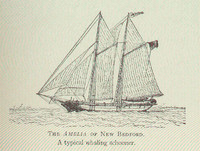Conclusion - Curations and Questions
A brief message (found in a bottle) from the Curator on Curation:
It is interesting to curate an exhibit with an already curated piece. It is important to note - we’re 4 layers of curation deep here. Firstly, to use a term from Garvey, the editors at the New Bedford paper “scissorized”, taking from the newspaper in Sydney, to run the story. Layer one. Next, William Tripp cut out of that New Bedford paper what he thought was important and pasted into his scrapbook. Layer two. Next, the New Bedford Whaling museum decided that this scrapbook was worthy of digitizing through the Internet Archive, and to put in their online collection. Layer three. Finally snippets of the scrapbook here, as I have compiled them to tell the story through the Omeka software. Layer four. It's curation all the way down.
Congrats on making it ashore! Any journey by sea has its perils, and I’m glad we got along, no mutiny required. I hope you learned something, about life on the sea or at least life on the couch, with the scissors in hand, scrapbooking.
Have you ever been sailing?
Have you ever made a scrapbook?
What do you do with information you think is important?
